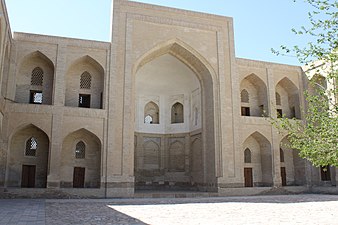Chor Bakr
Chor Bakr (completely Uzbek Chor Bakr meʼmoriy majmuasi ) is a necropolis near the Uzbek city of Buxoro .
location
The necropolis is located in the town of Sumitan, bordering the urban area of Buxoro, about 5 km west of the historic center of Buxoro .
history
The burial site of Abu Bakr Said, who died in 970/971, was at the site of today's Chor Bakr . He was a descendant of the Prophet Mohammed was considered an ancestor of the Juybar - Sheikhs , who formed a spiritual authority in the area of Bukhara. Older structures date from the 10th to 13th centuries. The facility at that time only took up about a tenth of the area it is today.
The main part of the current complex was built in the years 1560–1563 under Khan Abdullah II . The Khan from the Scheibanid dynasty , who ruled Buxoro since 1556, created a representative family burial site for the Juybar sheikhs. Further structures were added over the centuries, most recently a small minaret at the beginning of the 20th century.
The name "Chor Bakr" (four Bakr) is said to refer to four bearers of the name "Bakr". However, only two are known to be buried here. The name can also be interpreted as "four brothers".
In 2008 Uzbekistan put the necropolis on its list of proposals for UNESCO World Heritage .
description
The plant has an area of about three hectares . The center is formed by three interconnected buildings, which are arranged in a U-shape around an approximately 18 m wide and 20 m deep courtyard. In the south there is a chanaka, opposite it in the north a cross-dome mosque, and on the west side of the courtyard a courtyard mosque open to the courtyard. All three buildings have a pishtak with Ivan on their east side . All buildings have two-storey loggias facing the courtyard, which gives the ensemble the appearance of a madrasa . There is a minaret in the center of the building and a water basin in front of the cross-dome mosque.
Other structures and graves are spread across the complex. Many of these structures are built as “chasira”, that is, walled courtyards without a roof, to which an entrance with an ornate door or an ornate grille leads. One or more graves or tombs then lie within the partly paved courtyard. This design is a special feature of the Chor Bakr necropolis. A corridor made of brick walls about fifty meters long and open at the top leads to the Chasira with the grave of Abu Bakr Said.
In the north of the necropolis there is a garden, also dating back to the 16th century, in which poplars , willows , sycamores and fruit trees grow.
literature
- Klaus Pander: Tschar Bakr (Char Bakr) . In: Central Asia . 5th updated edition. DuMont Reiseverlag , Ostfildern 2004, ISBN 3-7701-3680-2 , p. 256 f . (DuMont art travel guide).
Web links
Chor Bakr on the website of the UNESCO World Heritage Center for tentative lists.
- The Chor-Bakr necropolis at Doca Tours
- Chor-Bakr Necropolis, Bukhara bei Advantour (English)
Coordinates: 39 ° 46 '27.7 " N , 64 ° 20' 2.4" E




